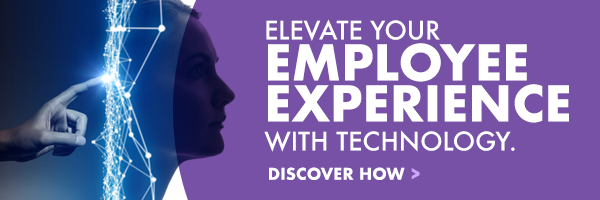4 Trends Driving Technology in the Workplace


Technology is one of the three biggest factors that impact the employee experience, along with the physical space and company culture. And while every employer provides its workforce with some sort of technology, many have not taken into account how swiftly the technological landscape progresses.
As a result, the software and hardware they offer their workforce may be woefully inadequate. And if an employer doesn’t offer its workforce the up-to-date technology it needs, it shouldn’t be surprised when retention and recruitment start to suffer. It is the responsibility of all organizations to recognize and prepare for the future of workplace technology. Here’s a quick look at how technology in the workplace has evolved and what trends are impacting it today.
The Evolution of Technology in the Workplace
The evolution of technology in the workplace has been largely driven by a desire to automate manual processes, connect disparate systems and collect more accurate data to inform decisions.
It started with architects using computer-assisted design (CAD) systems to plan their new office buildings in the 1960s. That evolved into computer-aided facility management (CAFM) software systems workplace managers still use today to visualize floor plans and gain occupancy data. Then came the development of the integrated workplace management system (IWMS) in the 1990s. The introduction of cloud computing and a greater emphasis on data analytics allowed organizations to achieve an even greater ROI with IWMS software, and the software itself became more comprehensive and powerful.
While an IWMS sets the foundation for streamlining many functions that contribute to the employee experience, it hasn’t traditionally been viewed as a solution for employees. Today, as more organizations make the employee experience a top priority, the conversation shift around technology is also shifting to be centered around empowering employees. As facilities managers, HR professionals and IT professionals seek to implement new technology, they should keep the following workplace trends and takeaways in mind.
Technology in the Workplace: 4 Trends
1. The Trend: A Move Toward Flexible Workplace Strategies
As real estate prices rise and employees seek greater flexibility, more organizations are adopting flexible workplace strategies, such as hot-desking, hoteling and activity-based working (ABW). In addition to being cost-effective, these strategies enable employees to choose the spaces they need to work as efficiently as possible.
The Takeaway: Employees Need an Easy Way to Find and Reserve Space
In an activity-based workplace, employees have access to various spaces throughout the day, depending on the work they’re doing. For instance, if they are working on a big presentation and need to concentrate, they might book a quiet space in the morning and reserve a collaborative space when they’re ready to share it with the rest of the team.
2. The Trend: The Gig Economy
Freelancers and independent contractors are expected to make up more than 43 percent of the workforce by 2020. They may not have an assigned desk, but they’ll still need to be able to check in and find a place to work each day.
The Takeaway: Contractors Need an Easy, Secure Way to Check In
With more contractors coming and going, more organizations are ditching paper sign-in sheets in favor of visitor management software solutions.
If you’re already taking steps to modernize your company, why not invest in visitor management software? Having a receptionist greet guests when they arrive is certainly ideal, but not always realistic. Using a kiosk or an iPad along with visitor management software allows employees and clients to check in and alert their colleagues of their arrival.
3. The Trend: Employees Expect User-Friendly Workplace Technology
The number of mobile apps on the market continues to grow at an impressive rate, with more than 100 new apps being introduced every hour. In just the past 10 years, the number of apps has grown from just 5,000 to nearly 5 million. Employees use these apps to manage everything from grocery shopping lists to their finances, and they expect the technology they use in the workplace to be just as user-friendly.
The Takeaway: Workplace Technology Must Be Mobile
Employees need to be able to find places, find people and find information throughout the day, wherever they happen to be working. Mobile apps and interactive kiosks that help employees or visitors access maps and important announcements throughout the day are becoming more common.
4. The Trend: Facilities Managers Are Expected to Do More With Less
As more organizations adopt the Six Sigma approach and focus on eliminating unnecessary tasks and expenses, facilities managers are expected to do the same. Many are assuming a more strategic role of making recommendations to reduce costs and improve operations, leaving less time for routine tasks like building maintenance.
Smart businesses don’t force one facilities manager to supervise an entire team of service technicians and monitor the status of dozens of different service tickets for issues all over the facility on his or her own. Instead, they implement facility maintenance software to help with on-demand, scheduled and preventative maintenance.
The Takeaway: Facilities Managers Need to Streamline Work Orders
Dealing with routine maintenance and service requests can easily become time-consuming. Throughout the day, facilities managers may be peppered with emails, phone calls and Post-It notes about broken chairs, equipment that needs to be fixed or rooms that need to be cleaned. Having a digital system that allows employees to submit service requests and helps FM leaders assign and prioritize such requests makes this workload easier to manage.
It can sometimes feel to an employer as if its employees are its children, but in this case it’s absolutely acceptable to spoil them. Evaluate your current workplace to identify future needs, update the workplace accordingly and then enjoy the sight of an engaged, happy workforce.
Learn more about how you can use technology in the workplace to elevate the employee experience.
